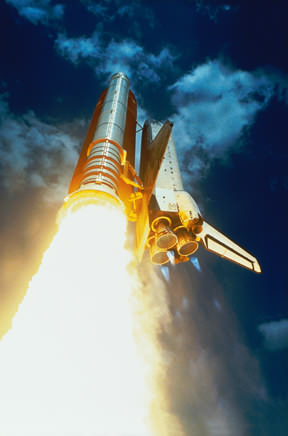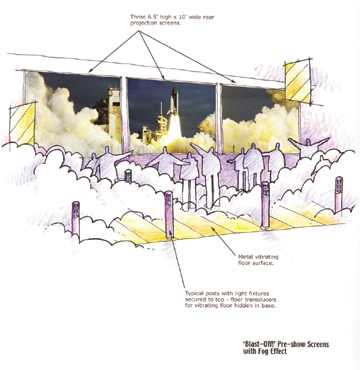Houston Space Center
| HOUSTON SPACE CENTER THEATER BLASTS OFF ANEW– WITH AN ASSIST FROM BAG END | |||||||
 |
|||||||
| It’s a challenge that parents and educators have faced forever – How can we combine fun and learning?
At least one answer can be found deep in the heart of Texas – at Space Center Houston, official visitor center for NASA’s Johnson Space Center. “We are a very unique venue,” Space Center Marketing Director Roger Bornstein says. “We are Houston’s home of intelligent fun. We combine pure, unadulterated fun – like going to amusement park combined with a visit to a totally cerebral museum.” |
|||||||
| The Space Center, a non-profit organization, recently unveiled a total make-over that celebrates the accomplishments of NASA and the U.S. manned space program with dynamic breath-taking productions and exhibits that put visitors right in the middle of the action.
Centerpiece of the new sizzle at Space Center Houston is “Blast Off Theater.” The production brings the sensation of a shuttle space mission blasting off from Cape Canaveral so up close and personal that guests are completely immersed in the sensation of the lift off: the roar of the igniting rockets is nearly deafening, the room vibrates and the crowd is enveloped in simulated rocket exhaust. “’Blast Off Theater is one of the expressions of intelligent fun,” Bornstein said. “Not only is it tremendously entertaining – demonstrating what it’s like to be an astronaut blasting off into space – but it’s also presented in a fun format. We constantly hear comments like, ‘Boy that was one of the coolest things we’ve ever seen.’” |
|||||||
Also as part of the new approach, another exhibit, the Mission Briefing Theater, has been completely renovated to bring visitors into the middle of Mission Control at the Johnson Space Center where they see and hear live reports on current NASA projects, crews and the International Space Station. |
|||||||
 |
|||||||
| Vista Collaborative Arts of Vancouver, British Columbia, one of the foremost designers in the world of immersive experiences for science centers, museums and expositions was contacted. Celina Ducceschi, exhibits director of the Space Center, told Vista’s Randy Ormston that they needed a new attraction, called Blast Off Theater, designed, developed and opened by mid-March of this year, an incredibly short lead-time.
“We looked at it, took a deep breath and said, ‘ Yes,’” Ormston recalls. “To pull this off, we needed to work in a collaborative way. Working with creative partner AldrichPears Designers, Masters Workshop, which specializes in special, large venue shows, and with renowned AV engineer Chris Sia, we took on the creative design and production. Space Center personnel, working with local suppliers, handled the building modifications.” Originally there were three parts to the project: Blast Off Theater, Mission Briefing Theater and a Mission to Mars exhibit which details a manned mission to the red planet, complete with a surround audio track. Sadly, a fourth element had to be added when the Shuttle Columbia crew was lost shortly before the new Space Center was to open. Vista’s major challenge was to “launch” the space shuttle mission in a relatively small 3,200 square-foot theater with a 10-foot ceiling that seated 250 visitors. “We began with three 10-foot wide rear projection screens,” Ormston said. “We used high definition video photography and special physical effects. As an example, when the shuttle launches a large cloud of water vapor and smoke billows up on the actual site. We filled the theater room with liquid nitrogen vapor at that point to re-create the look and feel of the real thing. The gas cloud special effect was provided by Backstage Technologies of Orlando, Florida.” Key to a dramatic re-creation of the deafening sound of eight huge rocket engines igniting at lift-off was the sound system and the sound track. Sia, of CPS Electronics, designed a five-channel, five-track playback system off disk that runs directly into Crown amplifiers and then into the loudspeakers. Sia selected four Bag End Quartz quad-18 subwoofers to reproduce the big bottom end of the rockets’ rumble. That’s a total of 16 eighteen-inch subwoofer speakers in a 3,200 square foot room under a 10-foot ceiling. Quartz is a high output subwoofer cabinet loaded with four 18-inch woofers that – when controlled by a Bag End bass signal processor – has the ability to produce a flat response down to 8 Hz. The Quartz also boasts a power-handling capacity of 1600 watts continuous sine wave. Thus, they provided dynamic volume and frequency range for the size of the room, packing the dramatic punch needed to create a believable liftoff. Sia used five Bag End TA5000 Time-Aligned™ loudspeaker systems, one per channel, for mid- and high-ranges. The TA5000 speaker contains a 15-inch base/mid cone and a one-inch compression driver with horn, which provides Bag Ends trademark Time-Aligned™ clarity and wide dispersion. “A rich sound track was also critical to making the presentation convincing,” Ormston said. Sound designers Masters Workshop originally created and mixed the sound track in their Toronto studio, which is designed to create special venue productions, then took the track to the site and re-mixed it to suit the unique characteristics of the space. The result? “The sound is absolute incredible,” Bornstein said. “We toyed with having the floor shake but realized we didn’t need that. It would not have been as realistic as feeling and hearing the sound hit you, as it does now. It’s not that it’s loud, it’s how they’ve done it that makes the effect so terrific.” Ormston’s less-than-scientific analysis: “Your clothes and guts just shake with the roar of those rockets.” For the second part of the project, the Mission Briefing Theater, Vista re-fitted that theater with full five-channel surround sound capability, again using five Bag End TA5000 loudspeaker systems. In this theater, however, the heavy-duty Quartz speakers were not needed to simulate a blast-off, so Sia speced in a smaller subwoofer system, a Bag End D18E double-18-inch subwoofer system, to provide the bass. To insure the highest quality audio and video possible, fiber optics were used to bring in live audio and video feeds from the Johnson Space Center and the shuttle/ISS missions. “Prior to the redesign, visitors had to strain to hear the audio from one small speaker,” Ormston said. “So needless to say, the improvement there is also dramatic.” For the third part of the project, Vista created the “Mission to Mars” show on a manned mission to the red planet, complete with a surround audio track. Sadly, a fourth element had to be added to the design when the Shuttle Columbia broke up upon re-entry into the earth’s atmosphere Feb. 1, 2003, killing all seven astronauts aboard. “Although we had only five days in which to do it, we created a tribute to the Columbia and the seven brave astronauts of her final crew, which is shown in the Mission Briefing Theater,” Ormston said. “When we previewed the new exhibit for Johnson Space Center personnel, those who had attended launches in Florida were amazed how the launch we created felt like the real thing,” Ormston said. “Right down to the “crackle” in the air as the shuttle does the turn-over maneuver.” After viewing the new Blast Off Theater show, a young visitor gushed, “It’s like IMAX in 10D. I’ve never heard anything like it in the whole world.” |
|||||||
